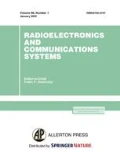Abstract
The most promising technologies of signal forming and multiple access have been considered from the viewpoint of bandwidth-time resource usage. They include the full duplex technology, subcarrier forming method using a comb filter bank, the non-orthogonal multiple access method, and the sparse code multiple access method. The main existing implementation schemes of full duplex communication based on the analog and digital proper transmitter in the reception channel are described. The filtering multifrequency signal system using a bank of comb filters is considered. The spectrum of such signal is shown to have a much weaker out-of-band radiation as compared to the existing subcarrier forming techniques. The non-orthogonal multiple access method and the sparse code multiple access method are investigated, and relationships of the bit error rates as a function of the signal-to-noise ratio for communications systems based on these methods are presented. It has been shown that the multiple access methods under consideration are more effective in the bandwidth-time resource usage as compared to the existing technologies.
Similar content being viewed by others
References
P. Marsch, I. Da Silva, S. E. El Ayoubi, O. M. Boldi, et al., 5G RAN Architecture and Functional Design, METIS White Paper (2016).
5G Initiative Team, NGMN 5G White Paper (2015).
5G PPP Architecture Working Group. View on 5G Architecture, White Paper (2016).
5G Network Architecture Design, IMT-2020 White Paper (2016).
V. O. Tikhvinskii and G. S. Bochechka, “Conceptual aspects of 5G creation,” Elektrosvyaz, No. 10, 29 (2013). URL: http://w.raenitt.ru/publication/5G_projects_elsv.pdf.
M. Jain, Jung Il Choi, Taemin Kim, Dinesh Bharadia, Siddharth Seth, Kannan Srinivasan, Philip Levis, Sachin Katti, Prasun Sinha, “Practical, real-time, full duplex wireless,” Proc. of 17th Annual Int. Conf. on Mobile Computing and Networking, ACM (2011), pp. 301–312. DOI: 10.1145/2030613.2030647.
Jung Il Choi, Mayank Jain, Kannan Srinivasan, Phil Levis, Sachin Katti, “Achieving single channel, full duplex wireless communication,” Proc. of Sixteenth Annual Int. Conf. on Mobile Computing and Networking, ACM (2010), pp. 1–12. DOI: 10.1145/1859995.1859997.
M. Duarte, C. Dick, A. Sabharwal, “Experiment-driven characterization of full-duplex wireless systems,” IEEE Trans. Wireless Commun. 11, No. 12, 4296 (2012). DOI: 10.1109/TWC.2012.102612.111278.
E. V. Rogozhnikov, A. S. Koldomov, V. A. Vorobyov, “Full duplex wireless communication system, analog cancellation: Review of methods and experimental research,” Proc. of XII Int. Siberian Conf. on Control and Communications, SIBCON-2016, 12–14 May 2016, Moscow, Russia (IEEE, 2016), pp. 1–5. DOI: 10.1109/ SIBCON.2016.7491777.
Dinesh Bharadia, Emily McMilin, Sachin Katti, “Full duplex radios,” Proc. of Conf. on SIGCOMM, 12–16 Aug. 2013, Hong Kong, China (2013), Vol. 43, No. 4, pp. 375–386. DOI: 10.1145/2534169.2486033.
R. R. Abenov, A. S. Vershinin, E. P. Voroshilin, and E. V. Rogozhnikov, “Research of equalization methods for the communication systems using OFDM signals,” Vestnik SibGUTI, No. 1, 50 (2013). URL: https://elibrary.ru/item.asp?id =19422242.
D. Kaplun, I. Kanatov, and L. Azarenkov, “Bank of digital filters,” Komponenty i Tekhnologii, No. 10, 156 (2007). URL: http://kit-e.ru/articles/dsp/2007_10_156.php.
M. Bellanger, et al., FBMC Physical Layer: A Primer (PHYDYAS, Jan. 2010).
5G Waveform Candidate Selection. URL: http://www.5gnow.eu/wp-content/uploads/2015/04/ 5GNOW_D3.1_v1.1_final.pdf.
S. N. Premnath, D. Wasden, S. K. Kasera, N. Patwari, B. Farhang-Boroujeny, “Beyond OFDM: Best-effort dynamic spectrum access using filterbank multicarrier,” IEEE/ACM Trans. Networking 21, No. 3 (June 2013). DOI: 10.1109/TNET.2012.2213344.
K. V. Balashova, N. A. Lobanov, and D. A. Dolgikh, “Filter bank multicarrier modulator,” Proc. of Vseros. Nauch.-Tekhn. Conf. Studentov, Aspirantov i Molodykh Uchenykh on Nauchnaya sessiya TUSUR-2012, 16–18 May 2012, Tomsk, Russia (Tomsk 2012), Part 2, pp. 75–78.
B. Farhang-Boroujeny, “ OFDM versus filter bank multicarrier,” IEEE Signal Processing Magazine 28, No. 3, 92 (2011). DOI: 10.1109/MSP.2011.940267.
M. J. Marcus, “5G and ‘IMT for 2020 and beyond’ [Spectrum Policy and Regulatory Issues],” IEEE Wireless Commun. 22, No. 4, 2 (2015). DOI: 10.1109/MWC.2015.7224717.
D. Soldani, A. Manzalini, “Horizon 2020 and beyond: on the 5G operating system for a true digital society,” IEEE Vehicular Technology Magazine 10, No. 1, 32 (2015). DOI: 10.1109/MVT.2014.238 0581.
Anass Benjebbour, Keisuke Saito, Anxin Li, Yoshihisa Kishiyama, Takehiro Nakamura, “Non-orthogonal multiple access (NOMA): Concept, performance evaluation and experimental trials,” Proc. of Int. Conf. on Wireless Networks and Mobile Communications, WINCOM, 20–23 Oct. 2015, Marrakech, Morocco (IEEE, 2015), pp. 1–6. DOI: 10.1109/ WINCOM.2015.7381343.
Yi Zhang, Hui-Ming Wang, Qian Yang, Zhiguo Ding, “Secrecy sum rate maximization in non-orthogonal multiple access,” IEEE Commun. Lett. 20, No. 5, 930 (2016). DOI: 10.1109/LCOMM.2016.2539162.
Linglong Dai, Bichai Wang, Yifei Yuan, Shuangfeng Han, Chih-lin I, Zhaocheng Wang, “Non-orthogonal multiple access for 5G: solutions, challenges, opportunities, and future research trends,” IEEE Commun. Magazine 53, No. 9, 74 (2015). DOI: 10.1109/MCOM.2015.7263349.
Ya. V. Kryukov, A. Ya. Demidov, and D. A. Pokamestov, “Power calculation algorithm in non-orthogonal multiple access NOMA,” Proc. TUSUR 19, No. 4, 91 (2016). URL: https://journal.tusur.ru/en/archive/4-2016/ power-calculation-algorithm-in-non-orthogonal-multiple-access-noma.
3GPP TS 36.211, version 9.1.0, 3rd Generation Partnership Project, Technical Specification Group Radio Access Network, Evolved Universal Terrestrial Radio Access (E-UTRA), Physical Channels and Modulation (2010).
H. Nikopour, H. Baligh, “Sparse code multiple access,” Proc. of 24th Int. Symp. on Personal Indoor and Mobile Radio Communications, PIMRC, 8–11 Sept. 2013, London, UK (IEEE, 2013), pp. 332–336. DOI: 10.1109/PIMRC.2013.6666156.
Hang Mu, Zheng Ma, Mahamuda Alhaji, Pingzhi Fan, Dageng Chen, “A fixed low complexity message pass algorithm detector for up-link SCMA system,” IEEE Wireless Commun. Lett. 4, No. 6, 585 (2015). DOI: 10.1109/LWC.2015.2469668.
D. A. Pokamestov, A. Ya. Demidov, Ya. V. Kryukov, E. V. Rogozhnikov, and R. R. Abenov, “Signal formation and processing for sparse code multiple access,” Elektrosvyaz, No. 10, 56 (2016).
D. A. Pokamestov, A. Ya. Demidov, and Ya. V. Kryukov, “Forming matrix of sparse code multiple access,” Proc. TUSUR 19, No. 3, 65 (2016). URL: https://journal.tusur.ru/en/archive/3-2016/forming-matrix-of-sparsecode-multiple-access.
Author information
Authors and Affiliations
Corresponding author
Additional information
Original Russian Text © D.A. Pokamestov, Y.V. Kryukov, E.V. Rogozhnikov, R.R. Abenov, A.Y. Demidov, 2017, published in Izvestiya Vysshikh Uchebnykh Zavedenii, Radioelektronika, 2017, Vol. 60, No. 7, pp. 367–382.
About this article
Cite this article
Pokamestov, D.A., Kryukov, Y.V., Rogozhnikov, E.V. et al. Concepts of the physical level of the fifth generation communications systems. Radioelectron.Commun.Syst. 60, 285–296 (2017). https://doi.org/10.3103/S0735272717070019
Revised:
Published:
Issue Date:
DOI: https://doi.org/10.3103/S0735272717070019




